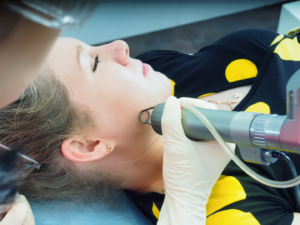Laser Resurfacing of the skin is the latest scar-clearing method that many people undergo in order to efficiently remove acne scarrings, uneven skin tone and even for rejuvenation purposes.
If you have ever had more serious problems with your skin – blemishes, acne, scarrings, marks, and wrinkles – you probably know of chemical peeling and dermabrasion as effective methods, but now there is a better and more sophisticated way of addressing your skin problems.
Namely, the skin resurfacing with the help of a laser holds a solid promise in reducing the damaging effects of the sun, the wrinkles of the skin, and many facial skin disorders, as a safe and convenient treatment for everyone.
It diminishes the imperfections of the skin by dissolving (layer by layer) the molecular bonds of the damaged skin cells. This is done until a smoother and an evener skin appearance is reached.
The fact that statistics show that Laser Skin Resurfacing is in the top 5 most preferred non-surgical treatments among patients, safely confirms that it delivers the wanted results as promised to do so, without any serious health risk.
 Since this is a procedure that takes a lot of patience and care after it is done.
Since this is a procedure that takes a lot of patience and care after it is done.
There are things you need to take into consideration before making a choice.
So it is highly suggested you consult with a professional who can introduce you to this method more personally based on your skin type and tell you if this is the right solution for you.
 This being said, here is a more general description of the right candidates for the laser skin resurfacing treatment:
This being said, here is a more general description of the right candidates for the laser skin resurfacing treatment:
Besides these guidelines of the right candidate for the method, patients should have rational and reasonable expectations of the results and be patient during the recovery period. The person should be well-educated on what to expect and also have the time to devote to the recovery once the procedure is done. This latter part is extremely important since there are patients who reported that the recovery period and the complete remodeling took even up to 18 months.
Note that a regular care and changing of moist bandages every hour in the first few days or so is required, but the good news is that infections are rare.
According to those patients, in all their cases, new skin appeared on the surface in as little as 10 days, however, this being a new, young and sensitive skin, the redness lasted for about two months after.
Another thing to consider is that up to 45% of the patients reported they had temporary changes in skin color, and this is why patients with lighter skin tones make better candidates than those with darker skin tone – there is less risk of permanent skin discoloration.
Before digging deeper into the tools with which this procedure is done and all the different types of lasers used for it, we would like to mention that according to the research and feedback from former patients, it is now known that this procedure is up to 90% more potent and precise when compared to dermabrasion (where a rough, abrasive edge removes the scars), and chemical peels (which uses chemicals to remove damaged layers of skin).
In order to acquaint you better with the entire procedure of laser skin layering, you need to know that there are 3 types of lasers which are named according to the source that creates the energy beam.

LASER stands for Light Amplification by Stimulated Emission of Radiation. A laser is a system or device which produces highly directional light with the different color combination.
It emits light through a process called stimulated emission of radiation which increases the intensity of light.
A laser is different from conventional light sources that are: monochromatic, directionality, high intensity, and coherence.

This laser is only to be considered by patients with the most severe skin conditions and scarrings that cannot be treated with the rest of the lasers.
The reason is that this is the highest intensity laser when compared to the other two.
The benefit of this particular laser is that due to the CO2 it uses, it makes the skin surface smoother, tighter and more uninformed.
This laser works by restricting the collagen bands in order to remove the wrinkles, scars, birthmarks and even warts. It might be useful to know that this laser has been used to treat cancer cells of the skin while in their beginning stages.
 Erbium Laser
Erbium LaserWhile different lasers are used in certain procedures and skin types, the Erbium YAG laser performs best in improving darker skin.
Compared to the above mentioned CO2 laser which is considered to be more powerful, the erbium laser is more precise at removing thinner layers of skin tissue in order not to cause any unnecessary skin damage.
This also makes it a great option for people who have fairly good skin, in a solid state but want to treat minimal fine lines and wrinkles only.
 Fraxel® Laser Skin Resurfacing
Fraxel® Laser Skin ResurfacingThe Fraxel® laser differentiates from the first two lasers in a manner that its procedure is non-invasive, and there are few post-treatment side effects caused by it.
Practically, there has been no pain or skin tenderness reported from patients and the best thing about it is that it requires no downtime for healing.
However, being this gentle on the skin, you should take into a consideration that is the least powerful of all three and that more sessions are required, instead of just one like with the rest.
Also, results appear gradually over the course of few weeks or even months at a time, depending on the condition of your skin.
 Now that you know quite enough about the lasers, we are sure you have questions regarding the entire procedure and how much it costs.
Now that you know quite enough about the lasers, we are sure you have questions regarding the entire procedure and how much it costs.
It is done with a local anesthesia for which an injection in the treated spot is injected.
However, if the patient asks, an oral sedative may be used as well. It is vital to take a break and give the skin a chance to cool off and not be so much heat-treated, so a partial laser resurfacing can take anywhere around 30 to 45 minutes and a full one up to 2 hours.
The cost of this treatment depends on the doctor and the hospital you have chosen.
However, you need to know that there is a surgeon’s fee, the cost of the facility and anesthesia, and also expenses made from the pre- and post-operative care. This is why it is best for you to schedule a consultation where you will find out exactly what to expect.
 As mentioned before, choosing a laser resurfacing procedure for your skin will result in a more youthful look,
As mentioned before, choosing a laser resurfacing procedure for your skin will result in a more youthful look,
improving the skin’s texture and making it smoother.
It removes any accumulated dead skin cells caused by overexposure to the sun,
the polluted air or by the drying effects of the makeup products.
 Minor side-effects may appear after laser skin resurfacing among certain patients,
Minor side-effects may appear after laser skin resurfacing among certain patients,
but they usually disappear in a short amount of time foreseen for the recovery period.
The most commonly reported side effects include redness of the skin, swelling of the treated area,
and moderate irritation similar to the feeling produced by a mild sunburn.